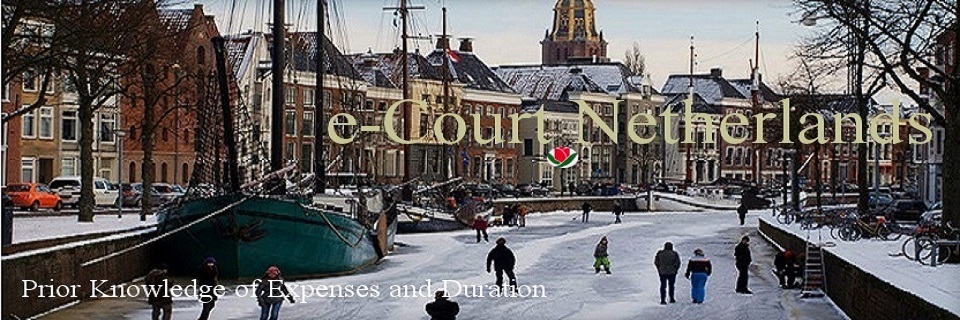But an important distinction remains. Continental law is much more systemised than Anglo-American law and its rules are intended to regulate many potential situations. So it’s possible to write all these rules down in a Civil Code. In continental countries, like France (Code Civil), Switzerland (Code Civil), Germany (Bürgerliches Gesetzbuch), Italy (Codice Civile), Spain (Código Civil), Belgium (Burgerlijk Wetboek) and also the Netherlands (Burgerlijk Wetboek), civil law is dominated by one general statute book – the Civil Code -, which is the foundation of all other acts and regulations of civil law. Anglo-American law countries don’t have such a basic Civil Code. The foundation of their civil law is formed by the construction of all judgements which are generally recognised by scholars, judges and government as the precedent decisions. As a result, law students in Anglo-American law countries, who want to understand the roots and principles of their legal system, study - instead of the main rules of a Civil Code - the most important precedent judgments that in course of time have been rendered in relation to various legal subjects.
But the difference between continental law and Anglo-American law lies not just in the mere fact of codification. One should be aware that also in a few continental law systems, like that of Scotland and South Africa, and in fact even that of the Scandinavian countries, a basic Civil Code is missing. Thus, such a basic codification is by no means a defining characteristic of a continental law system. The main difference can be found in the way how the law is approached. In continental law systems this approach is methodological and systematic, not only in creating new law, but also in solving individual cases. The rules of law have a general impact and are issued to regulate all kinds of potential (possible) situations. Because of this, continental law countries are able to catch the significant rules in a central code, whereas the judge-made law of Anglo-American systems is so divers and crumbled that it’s impossible to write it all down in a logical and systematic book. In continental law countries, legislation is seen as the primary source of law. That’s why judges tend to look for solutions that will fit in the system of the law, taking into account the intention of the legislator for passing this rule, as expressed in the Parliamentary history of this specific law. This means that judges, when a certain subject isn’t regulated directly by statute law, will search for the general principle behind the law and, if possible, fill up the legal gap in analogy with that principle. So the influence of the act or statute is widened. By contrast, in a common law system, cases and the legal principles behind them are the primary source of law, and statutes are seen as a specific correction of it. Consequently, the statute has to be interpreted narrowly.
For a more extensive explanation on the differences between civil law and common law, see the report ‘A Primer on the Civil-Law System’ by James G. Apple and Robert P. Deyling. See also 'Mixed jurisdictions: common law vs civil law (codified and uncodified)' by William Tetley.
Property rights in rem and property rights in personam
Dutch civil law results, as all continental law systems, from Roman law. As far as property law and contract law are concerned (both forming the law with respect to assets and commercial and financial relationships), the distinction between rights in rem and rights in personam is the most significant one. Rights in rem regulate the legal relationship of a person towards a certain object with regard to the rest of the world, whereas rights in personam (debt-claims) regulate the legal relationship between two persons (the creditor and his debtor).
Rights in rem are property rights, linked to a certain object, with ‘real effect’. The proprietor of such a right can sustain his powers against everyone in the world. Everybody must respect his right and no one is allowed to disturb him in exercising his powers. These rights and powers are always connected to a certain object, such as a movable or immovable thing. Everyone who could encounter this object, has to observe the powers which the proprietor of the property right may exercise over it. Thus, the proprietor of a property right in rem exercises his powers directly with respect to the object itself, regardless who actually keeps it under control ('in rem' is Latin for 'in a thing').
Continental law systems know the so-called ‘numerus clausus principle’. This means that there are only a limited number of rights in rem and also that their content is well defined by law. It's not possible to create other property rights in rem outside these legal standard types. This also applies to Dutch property law, that recognizes the following eight rights in rem: ownership, long leasehold (also known as emphyteusis or perpetual quitrent), easement (servitude), right of superficies, apartment ownership, usufruct, mortgage and pledge. Long leaseholds, easements, rights of superficies, apartment rights and mortgages are only connected to immovable property. Ownership can be related to both, movable and immovable things, whereas a pledge can not be vested on immovable property, but only on movable objects as well as on debt-claims and (intangible) rights, like intellectual property rights. Usufruct can be established on all kinds of objects, therefore on movable and immovable property, debt-claims, intellectual property rights and so on.
Property rights in rem are to be distinguished from property rights in personam. These last rights can be exercised only against one particular person (or one specific group of persons). In Dutch property law these rights in personam are usually claims resulting from an obligation (therefore called ‘debt-claims’). The holder of such a debt-claim is a creditor who may demand that a specific person - his debtor - fulfils the indebted performance. A property right in personam is, as a consequence, never immediately connected to a thing, but always to a specific performance which has to be carried out by a particular person, the debtor. Its effect is relative. The right of the creditor to demand performance is called a debt-claim. In contrast to property rights in rem, Dutch civil law puts no limitations to the content of property rights in personam to be created, although it's always a debt-claim arising from and within an obligation. The creditor and debtor may make almost every performance the object of their contract or obligation (‘open system’), but there's just one overall legal form in which they can construct their legal relationship, and that’s an obligation, for which the law entails special provisions in Book 6 of the Dutch Civil Code. Though the content of an obligation can vary in many ways, the structure is always the same: a debt imposed on the debtor that has to be satisfied on behalf of the creditor; an opposite debt-claim of the creditor against the debtor of which performance may be demanded.
Nevertheless there are other legal duties which as well have to be observed only by one specific person, but which cannot be classified as obligation. Therefore, in those situations, from the point of view of the person entitled to demand compliance, one cannot speak of a 'debt-claim'. Usually these other claims are imposed directly by law. Their influence and effects resemble those of a debt-claim. In practice it’s hard to make a distinction between them.
This systematisation in rights in rem and rights in personam, which appears in all legal systems on the continent, is unknown in Anglo-American law. Nevertheless, in Anglo-American literature the distinction between rights in rem and rights in personam is sometimes discussed, particularly concerning the question what the legal character is of the right of a beneficiary in a trust fund. And although this way of questioning is, to a large extent, abstract and theoretical for Anglo-American lawyers, it can help an Anglo-American lawyer to understand the system of continental law and, vica versa, enables lawyers from continental law countries to study Anglo-American law. Of course, in practice an Anglo-American lawyer, when acting within his own legal system, immediately reverts to the meaning of the property rights that he knows so well, without making a distinction between rights in rem and rights in personam. But also in Anglo-American law there is an important difference between rights that can be enforced against the whole world and rights from an obligation that can only be upheld against a certain debtor.
In Anglo-American property law the distinction between rights in rem and rights in personam isn’t the main one. This system especially differentiates between property rights in immovable objects and in movable objects. Although the distinction between movable and immovable objects also exists in continental law, property law in continental law countries is nevertheless considered as one uniform system, applying to all property rights with regard to every kind of object, movable or immovable. This kind of unity doesn't exist in Anglo-American law. That’s why property law is one of the most difficult fields of law in Anglo-American law systems.
e-Court handles civil cases in accordance with either the common and/or the civil-law traditions in the Netherlands
(continued 1/3)

-
TOPICS:
- HOW IT WORKS
- home
- preliminary information
- introduction
- small claims court
- e-Court, how it works
- CIVIL LAW
- standard procedure
- appeal process
- hearings
- a legally binding verdict
- member of e-Court
- join e-Court
- terms, rules & regulations
- find a lawyer
- ( demo : Preliminary info )
- ( demo : The Standard Procedures )
- ( demo : The Appeal Procedures )
- OFFLINE NETWORKING
Endorsements ( 1/2000 + ):
- Miller Thomson LLP
Gerald Chipeur, QC, Partner Calgary, Alberta - Adair
Morse LLP
John Adair, Toronto, Canada Area Law Practice - Bart
Law
Jaqueline Bart, Canadian Immigration Law - FreemanLaw -
Barristers
Derek Freeman, Toronto, Ontario, Law Practice - Abrams &
Krochak-Lawyers
Toronto, Ontario, Law Practice - Ennis Milne - Barristers & Solicitors
Toronto, Ontario, Law Practice - Partner,
Gilbertson Davis Emerson LLP
Past President, Ontario Bar Association - George A.
Bougadis
Toronto, Ontario, Canada Law Practice - Rick
B
Calgary, Canada Area Industry Law Practice -
Patrick Cormier
Canadian Centre for Court Technology Montreal, Quebec, Canada - Jonathon Baker
Toronto, Canada Area Law Practice - Patricia M. Swerhone
Waters and Associates, Barristers & Solicitors, Toronto - Kenneth J. Byrne
Immigration and Real Estate Lawyer at Benson Buffett, Newfoundland And Labrador - Amy M. Crosbie
Partner at Curtis, Dawe, Newfoundland And Labrador - Justice Clark
Partner at Simmons Da Silva + Sinton LLP, Toronto - Stanley Potter
Owner, Stanley J. Potter, Barrister & Solicitor, Toronto - Phil Birss
Group Marketing Manager at NRL - Robert Cornish
CEO at Richter Group of Companies - Michelle Findlay
Group Marketing & Partners Director ITS Technology Group - Dyanne Fries
CEO - Design, Print and Digital Publishing - David Achim
CEO/President at SkyFiber, Inc. - Brian Adams
Manager Proposals/Business Development at Leebcor Services, LLC. - Julian Alcolea
Director de Administración Pública en Efron Consulting - Tahar Ali-Yahia
Founder, Corporate Leadership NexGedia Enterprise - Anthony Argenziano
Head of Technology eBay Enterprise - Anthony Argenziano
Head of Technology eBay Enterprise - Mike Arnold
Managing Director specializing in the logistics of Global Mobility, Records Management and 3PL across Asia Pacific. - Matteo Arru
Knowledge Management Officer European Institute of Innovation and Technology - EIT. - Victor Artemiev
Vice President (investment & business development) at Eurasian Development & Management Company - Robin Austin
Executive Strategy & Planning, Market Strategy Marketing Business Development Strategy Marketing Business - ( Endorsements continued.....)















